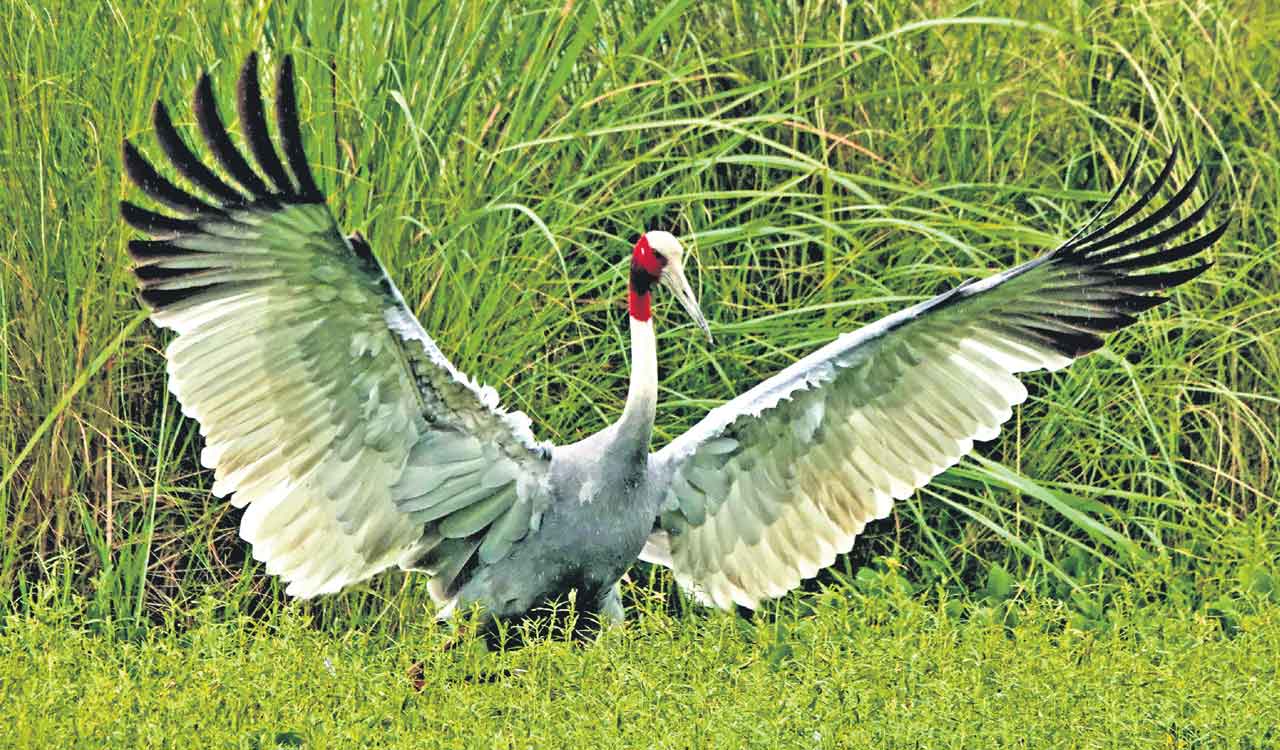Rewind: Saving Sarus
Will the non-migratory sarus crane, which now mostly survives by the scruff of the neck, thrive together with the rustic folk?

By N Shiva Kumar
Located a mere 70 km from the Delhi border, the Dhanauri Wetlands in NCR-Greater Noida offer a conducive habitat for the tallest flying birds in the world, the sarus cranes. If one is lucky, on any given day on a hot summer evening, there can be over 100 sarus cranes in a communal roost jostling for space in the lake waters, a rare but splendid spectacle of crane culture.
Dhanauri is a small natural wetland spread over 240 acres as listed in the National Wetland Inventory & Atlas (NWIA). It is skirted with lush crop fields and inhabited by nature-loving villagers in the countryside. Regular birdwatchers from the Delhi-National Capital Region insist that “it is a good habitat for water birds particularly during winters when hordes of migratory birds throng” and especially for sarus cranes that are seen around the year but in varying numbers. Lately, similar wetlands and lakes that harbour waterbirds and other species are under severe threat, spelling danger for the sarus cranes and doom for the lake waters disappearing due to concrete constructions.
Today, the world’s tallest flying bird is contented living among rice fields flooded with water and has a cosy connection of coexistence with farmers in the countryside
Since ancient times, sarus cranes in India have been revered and known not only for their extreme fidelity but also for their dramatic dance rituals performed before and during mating, and even after the nesting season. They have been explicitly painted on pages of Akbar Nama (Book-of-Akbar), the official chronicle of the reign of Akbar, the third Mughal Emperor (1556–1605) of India. Currently, the bird is thriving independently in western and northern India, Southeast Asia and Northern Australia. They have more-or-less decimated from our neighbouring countries and now majorly survive by the scruff of the neck in India, says an official from the International Crane Foundation (ICF) stationed in India.
Friends of Farmers
Today, the world’s tallest flying bird is contented living among rice fields flooded with water and has a cosy connection of coexistence with Indian farmers in the countryside. The population of sarus cranes in India is commendable, despite all odds because they inhabit agricultural wetlands close to human habitation. The sarus crane (Antigone antigone) is a kind of complex conservation coincidence, say bird scientists. Unlike many wildlife species, these tall birds, with steel grey feathers, blood-red heads and majestic presence, appear to have benefitted from the booming agricultural landscapes.
Thanks to the Green Revolution, large parts of India were artificially soaked and sowed for grain with constant irrigation projects to cater to the ever-increasing humans. Surprisingly the overall population of sarus cranes has increased in certain areas even though they have gone extinct in certain isolated spots of the country. These majestic birds are found in certain preferred parts of Uttar Pradesh, Haryana, Madhya Pradesh, Rajasthan, Gujarat and Maharashtra. Once upon a time, they were found down south right up to Karnataka, and now have disappeared for unknown reasons. Excessive government projects, developmental schemes and private entrepreneurs making unplanned “concrete jungles” for human accommodations could be reasons.
Efforts to declare the Dhanauri wetlands in NCR-Greater Noida as a sarus sanctuary or a conservation reserve have fallen on deaf ears
The Dhanauri Wetlands were discovered only in 2014 by Anand Arya, an ardent ornithologist and nature lover. The wetlands play host to over 50,000 birds belonging to 216 species during the migratory season. The biodiversity in terms of aquatic plants, herbs, shrubs, trees, grasses etc, varies according to the availability of the water content. Dhanauri marshlands represent over one per cent of the biogeographic population of sarus cranes and have about 23 endangered species of which, 13 are near threatened.
Arya has regularly recorded over 100 sarus cranes in the last seven years at these wetlands and also made a short film on the wetlands, available on YouTube. He is persistently in pursuit of the protection of Dhanauri Wetlands and declaring the area as a sarus sanctuary or a conservation reserve. Unfortunately, even after providing all requisite documents and data for the last five years to both State and central governments, the bureaucracy is dragging its feet in proclaiming Dhanauri as a national and international asset.
Uttar Pradesh has declared sarus cranes the State bird as 70% of their population found in India resides within its boundaries
Lovey-dovey Pair
The first time I saw the splendid sarus crane was at the 29 sqkm Bharatpur Bird Sanctuary of Rajasthan in 1987 as two pairs walked nonchalantly with the feral cattle at Kadam-Kunj marshlands. It is a pleasure to watch a lovey-dovey pair, standing side by side, grooming or partaking in silent gossip. They even utter guttural calls in unison that shatter the silence of the lingering landscape and also reassure themselves of their mated status. Since that first encounter, the sarus crane has been my muse for three decades now, observing and shooting photos as they move about probing for juicy morsels in the wetlands, grasslands, and even fallow drylands.
It also happens to be the State bird of Uttar Pradesh as 70% population of sarus found in India resides within its boundaries. The mighty perennial Ganga River with multiple tributaries passes through the entire geography of UP and keeps the terrain naturally well-irrigated. These waterways continuously help refresh and retain wetlands during cultivation by farmers has led to the proliferation of mosaics of marshy stretches. Favourable conditions have given a geographical advantage to over 300 species of aquatic birds, particularly the dominating sarus cranes, for feeding, breeding and brooding in UP.
Professor BC Choudhury, executive trustee of Wildlife Trust of India (WTI) and wetland resources professional, is the first-generation wildlife biologist of India who spearheaded the first three national-level sarus count 25 years ago. His involvement with the community participation in the conservation of sarus crane and its wetlands habitats in eastern UP has paid rich dividends. He and his team have been identifying Important Sarus Wetland Sites (ISWS) in the agricultural landscape of eastern UP as the region was long ignored by giving preference to western UP.
Dr Choudhury explains that wetlands, the primary habitats of the sarus crane, are facing various forms of anthropogenic pressure like urbanisation and agriculture expansion, and intense use of harmful agrochemicals. Damage of nests and stealing of eggs, harassment by feral dogs as well as electrocutions by hi-tension wires add to the threats. The sarus population is largely outside the protected areas, primarily in agriculture-dominated landscapes dotted with wetlands.
Though paddy provides the bird a near-natural habitat, changing cropping patterns from rice to cash crops like sugarcane have reduced their habitat. Sarus, therefore, is now localised to areas where there is a mosaic of rice or wheat cultivation and natural wetlands. Uttar Pradesh has given the sarus crane an esteemed position by declaring it as the ‘State Bird’ but much more needs to be done. The Wildlife Trust of India with the support from Tata Trusts is involving the local community in the region in the conservation of cranes.
My best encounter with a sarus pair undoubtedly was in the winter of 2001-02 again at Bharatpur Bird Sanctuary. It was a cold and predominantly foggy day. Raju, my rikshawala, knew its whereabouts. “Let’s hurry up sir, we may have an exceptional sighting of the white crane at close quarters,” he exclaimed. He cycled 4 km to reach the spot and at the edge of the mud-bund, we could hear commotion of the cranes but nothing was visible. We waited, braving the chill, sitting on the cold grassy ground for half an hour.
As the mist vaporised, the first shafts of sunlight penetrated the wetlands and there was an extraordinary action-sighting of sarus cranes intensely protesting with a pair of Siberian cranes. The vocalisation and open-wing flapping went on for a while until the sarus pair succeeded in shunting the Siberian off their patch of swamp. I was just about 70 feet away from the birds with another birder-cum-photographer who was busy shooting. It was an extraordinary encounter, seldom seen in nature, but alas, that was to be the last sighting of the Siberian cranes as they never came back to our country. Presumed extinct in India! Will the non-migratory sarus crane face the same music or make up with the rustic folk to flourish in India?
Counting the Bird
The first three national sarus surveys aimed to research the ecology of the bird and provide the necessary baseline data for its habitat conservation. Country-wide information was pertinent to involve people from all walks of life both in the preservation of the species and also in spreading awareness. Though annual counts have been carried out at the Bharatpur Bird Sanctuary since the 1980s, nationwide quantitative data was unavailable. The Wildlife Institute of India and associated organisations in their three-year survey in 1999, 2000 and 2001 suggested that involvement of States and dedicated volunteers was essential to arrive at a realistic sarus status in the country. The report showed UP has had the majority of the sarus population and they invariably migrated within the State, spilling over into neighbouring wetlands in Bihar, Madhya Pradesh and Rajasthan. With no comprehensive survey conducted in recent years at the national level, the countrywide guesstimate of the bird’s population is pegged at 20,000-25000 by ornithologists.

(The author is an independent journalist and documentary wildlife photographer)
Related News
-
Cartoon Today on December 25, 2024
7 hours ago -
Sandhya Theatre stampede case: Allu Arjun questioned for 3 hours by Chikkadpallly police
8 hours ago -
Telangana: TRSMA pitches for 15% school fee hike and Right to Fee Collection Act
8 hours ago -
Former Home Secretary Ajay Kumar Bhalla appointed Manipur Governor, Kerala Governor shifted to Bihar
8 hours ago -
Hyderabad: Organs of 74-year-old man donated as part of Jeevandan
8 hours ago -
Opinion: The China factor in India-Nepal relations
9 hours ago -
Editorial: Modi’s Kuwait outreach
9 hours ago -
Telangana HC suspends orders against KCR and Harish Rao
9 hours ago
